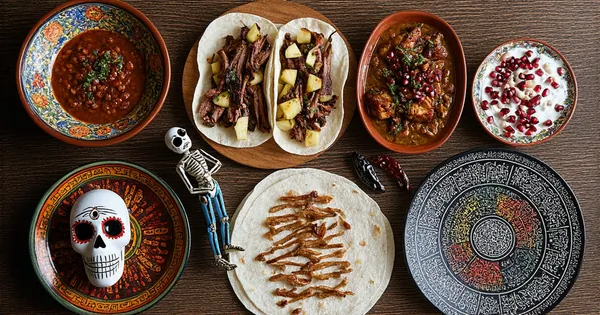
Mexico
Navigate Mexico's legendary street food scene with our expert guide. Discover authentic tacos, tamales, and regional specialties from Mexico City markets to coastal seafood while making informed choices.
The cuisine of Latin America and the Caribbean is a vibrant chronicle of history, geography, and culture. It's a vast culinary landscape stretching from the high Andes to tropical shores, where indigenous ingredients like corn and potato meet the flavors of Europe and Africa. Every dish, from a simple street taco to a complex mole, tells a story of migration, adaptation, and celebration. To eat here is to taste the soul of a continent.
The food of this immense region is best understood through its distinct culinary zones. Mesoamerica, covering Mexico and Central America, is the heartland of corn, where the nixtamalization process unlocked its potential, forming the base for everything from tortillas to tamales, always accented by chili and cacao. The Andes region of South America showcases a different agricultural heritage, with thousands of potato varieties, quinoa, and high-altitude cooking techniques. In contrast, the Atlantic coast, particularly Argentina and Brazil, is defined by its "asado" grilling culture and strong European influences. The Caribbean islands weave a different thread, with African culinary traditions, Creole spices, and an abundance of tropical fruits and seafood creating a uniquely bright and rhythmic flavor profile. These zones, while distinct, are united by a shared love for communal meals and fresh, bold flavors.
More than just a crop, corn (maíz) is the cultural and culinary backbone of much of Latin America, especially Mexico and Central America. The ancient process of nixtamalization—soaking kernels in an alkaline solution—unlocked its nutritional value and created the versatile dough ("masa") used for tortillas, tamales, arepas, and countless other staples. Its importance is foundational to the region's identity.
Across the Caribbean and much of Latin America, the "sofrito" (or "recaito" in Puerto Rico) is the essential flavor base for stews, beans, and rice dishes. This aromatic blend of ingredients like onion, garlic, peppers, and cilantro is gently sautéed to build a deep, savory foundation. It's the region's equivalent of a French mirepoix and the secret to a truly authentic taste.
Ceviche is more than a dish; it's a culinary technique that showcases the purity of fresh seafood. By "cooking" raw fish in citrus juice—typically lime—it embodies a core principle of Latin American coastal cuisine: highlighting pristine ingredients with bright, acidic flavors. Variations from Peru to Mexico demonstrate how a single concept can be adapted with local chilies, corn, and herbs.
A guide to distinguishing between three of Latin America's most beloved corn-based street foods.
Learn to navigate the vibrant local markets with confidence and find the best produce.
While they share a language and some history, their cuisines are vastly different. Spanish food is Mediterranean, built on olive oil, wine, cured meats, and seafood. Latin American food is built on an indigenous foundation of corn, potatoes, beans, and chilies, with Spanish ingredients adapted over centuries. For example, a Mexican "tortilla" is a corn flatbread, while a Spanish "tortilla" is an egg and potato omelet.
In many Latin American countries, lunch ("almuerzo") is the largest meal, often consisting of multiple courses and enjoyed over a longer period. This tradition stems from an agrarian past where a hearty midday meal provided energy for afternoon labor. Even in modern cities, the "comida corrida" or set lunch menu remains a cultural and economic staple, with dinner often being a much lighter affair.
No, this is a common misconception. While Mexican and some Peruvian or Caribbean cuisines famously use chilies for heat, many others do not. Argentinian food is focused on grilled meats and is rarely spicy. Colombian and Uruguayan cuisines are also very mild. In many places, hot sauce ("ají" or "salsa picante") is served on the side, allowing each person to add heat to their own taste.
Ceviche is a dish where raw fish is marinated and "cooked" in acidic citrus juice. The variations are significant. Peruvian ceviche, often considered the classic, is simple: just fish, lime juice, onion, chili, and cilantro, often served with sweet potato and large-kernel corn. In Mexico, it's typically chopped more finely, includes tomato and avocado, and is served with tortilla chips. Ecuadorian ceviche often includes shrimp and is served in a more tomato-based, soupy liquid.
At Tasteplorers, our mission is to provide the most accurate and useful travel information in the world. To achieve this, all content on this site is created through our unique editorial framework. We utilize leading AI research tools, guided by our proprietary prompts, and a multi-stage validation process. This entire system is overseen by our editorial team to ensure everything we publish meets our high standards for accuracy, cultural nuance, and practical value for travelers.
Learn more about our Editorial Process and our Mission.
Discover Europe's diverse culinary landscape, from Mediterranean flavors to hearty Alpine fare. Learn to navigate markets, decode menus, and eat like a local.
Explore Oceania's diverse food scene. Learn about Polynesian earth ovens, Fijian feasts, and the vibrant café culture of Australia and New Zealand.
Explore Southeast Asia's diverse food cultures from Thailand to Vietnam. Get expert tips on navigating spice levels, choosing quality vendors, and understanding the rich traditions of the region.